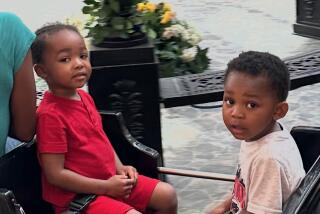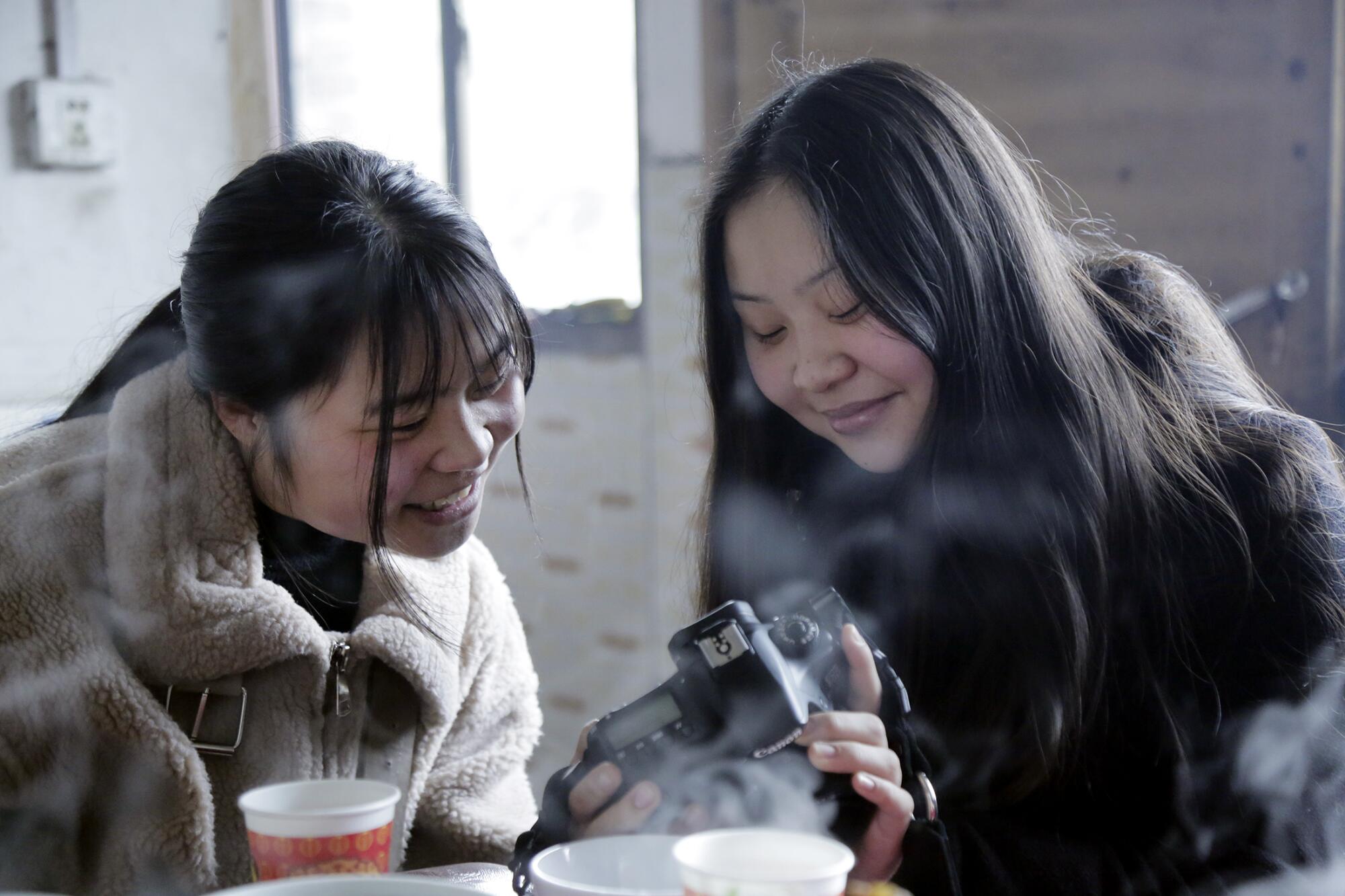
- Share via
On a cold afternoon in 2017, I was fighting off the urge for a nap when a message popped up on Facebook:
Ms. Demick. You contacted me a long time ago? Are you still interested in talking with me? If so, my family and I are interested.
I was the New York correspondent for the Los Angeles Times and was exhausted from covering the aftermath of the presidential inauguration. I tapped out a curt reply, saying I didn’t know who he was.
My mom adopted a little Chinese girl years ago … and it appears like she has a twin sister still in China.
I bolted upright. Of course I hadn’t forgotten.
::
In 2009, as a Beijing-based correspondent, I traveled the backwaters of central China to learn more about the origins of the more than 80,000 girls who had been adopted in the United States.
The prevailing wisdom was that rural Chinese had essentially thrown away their female babies because the law limited them to one child and they preferred boys. No doubt that was often the case. But reports were surfacing that government officials were snatching babies to satisfy a lucrative adoption market.
I went to investigate, traveling to remote mountain villages, sometimes leaving the car to hike because the roads were impassable.
One of the families I met in a village wedged between rice paddies in Hunan province had lost one of their twin daughters. Twins are normally permitted, but this family already had two older daughters.
The mother had given birth in a bamboo grove, trying to avoid detection by the government. She and her husband then fled to another province with one twin while leaving the other with an uncle and aunt. But one day when the girls were almost 2 years old, five men working for family planning stormed the house, restrained the aunt and took away the screaming toddler.
I met the twin who stayed with her parents when she was 9 years old. Her name was Shuangjie — “double purity,” in recognition of her status as a twin. She had a heart-shaped face and a pouting mouth, lips turned downward to mark her discontent. She sat next to her mother on a plastic stool outside a wooden shack.
Her mother, Yuan Zanhua, told me her daughter still grieved for her missing twin. “‘She’s always asking me, ‘When will you get my sister back? Where is she?’”

In 2002, a 2-year-old girl was confiscated by Chinese officials because her family had violated the one-child policy. In February, during Lunar New Year, she traveled from Texas, where she had been adopted, to meet her birth family and her twin sister.
Zanhua thought her daughter might have been adopted overseas, but she’d also heard rumors that babies were taken for organ donations. (I never found evidence to support such claims. In fact, parents from the U.S., Netherlands, Spain and Great Britain were flocking to China to adopt.)
“She could be anywhere in the world,” Zanhua told me. “I wouldn’t know where to look.”
As I got ready to leave, she brightened up for a final farewell.
“Come visit again, and next time bring our daughter.”
::
My story on officials abducting babies ran in September 2009 along with a story about the stolen twin. I moved on to other news, but Zanhua had laid down a challenge that would be hard to resist. I began to search.
Eventually, I found a Yahoo chat group for parents who had adopted from the Shaoyang Social Welfare Institute, the orphanage where I was certain the twin had been taken. Along with the concerned moderator, who let me join the group, we flipped through photos and descriptions. One girl looked like a possibility. The parents were evangelical Christians who had two adopted girls. They were an older couple, both previously married with children.
On Adopt the World, a website she created to help families adopt, the mother explained how their faith guided them: “When God births His passion in you, it doesn’t matter what the obstacles are.… It had to be because it was and is His will. God loves the orphan. God defends the orphan. God is a Father to the orphan, and is just waiting for us to care for them the way He does.”
On the website were two photos of the girl I suspected was the missing twin — a blurry head shot of a toddler with thin hair and downcast eyes, another of a smiling 4-year-old in a puffy blouse.
I didn’t want to raise false hopes for Shuangjie’s family, so I borrowed a technique from police procedurals — mug shots. I arranged the two photos on a page with random images of Chinese girls plucked from the internet. I mailed the page to Hunan, with an offhand note saying these were adopted girls and just maybe one resembled their daughter.
Within a day of receiving it, the family called my office. They’d picked out not one, but both photos as their missing daughter, who had been named Fangfang. They were certain.
I reached out to the American family, but it was quickly apparent they didn’t want to cooperate. As soon as they learned of my queries, they removed the photos from the internet.
I later learned that the adoptive father had died the year before at the age of 66. Through the obituary, I got the names of the couple’s adult children. I sent messages that went unreturned. The chat room moderator contacted me on behalf of the adoptive mother basically asking that we back off:
“She and her family are still deeply grieving her husband’s death and I don’t think she is ready or able to deal with this at present.”
This presented an ethical dilemma. Did I have an obligation to tell the Chinese birth parents where their daughter was? Did I owe it to the adoptive family to keep their privacy?
In the end, my editors and I were in agreement: It was out of the question to write a story that exposed a 9-year-old girl as being a stolen Chinese child. So I sent all the information I had gathered to the adoptive family. I told the birth parents that I believed their daughter was alive and well in the U.S., but couldn’t be contacted at that time. I didn’t hear back from them.
Meanwhile, the story of the stolen babies became a big scandal in China, threatening a billion-dollar adoption industry. Many Chinese journalists traveled to Hunan to write about the missing twin and, from time to time, would contact me to ask for the whereabouts of the girl in the United States.
“The family says you know where the twin is but won’t tell them,” one journalist chastised me.
I continued to explore the issue, writing about a family that made a business trafficking baby girls and an obstetrician who stole babies. But I never revealed the name of the American twin. Not until now.
::
Her name is Esther Frederick. She lives on the outskirts of Fort Worth with her older adopted sister and her mother, Marsha Frederick. It was Marsha’s adult son from a previous marriage who had contacted me on Facebook.
Esther was now 16 and wanted to get in touch with her sister. The family trusted me because I’d kept their secret for eight years. Now they wondered: Could I help?
So began a gradual process. A filmmaker working on a documentary about Chinese family planning finally gave me the contact information on WeChat, a messaging app, for Zeng Shuangjie.
Since Shuangjie didn’t speak much English, and Esther remembered not a word of Chinese, I became their courier, sending and translating messages between them.
“Dear Shuangjie,” the first letter began. “I’m Esther. Please allow me to introduce myself.”
Esther explained that she had just completed her high school studies (she had been home-schooled and was living at home). She was starting her own photography business. Just to avoid raising expectations that she’d move back to China, Esther added a pointed rejoinder: “I am very happy and want you to know that I have a caring and lovely family whom I love dearly.”
Shuangjie picked up immediately on Esther’s meaning.
“We very much want to see you and hope your family is not afraid,” she wrote back. “We won’t snatch you away from your family. We understand. I hope we will keep in touch in the future.”
Dear Shuangjie, I’m Esther. Please allow me to introduce myself.
— Esther Frederick
The girls continued to exchange messages. Esther wrote of her interests — photography, art, baking, fashion. Shuangjie wrote of her own — badminton, pingpong, music and writing Chinese characters. They discussed favorite colors.
They were like pen pals without real intimacy, struggling to find common ground. Esther was still nervous about revealing too much of her identity.
After a few months of aimless electronic chitchat, the girls wanted to talk. I was on vacation in China and arranged to go through Hunan to set up a video chat.
Shuangjie by then was living in Changsha, the capital of Hunan, about a six-hour drive from her village. She had attended a vocational high school for teacher training and was working as a teacher’s aide in a kindergarten.
When we met at my hotel, I didn’t recognize the pouty little girl I’d interviewed in the bamboo forest. Her face was so broad that her cheekbones protruded like a boomerang, her smile stretching wide across. She was nervous and had brought a roommate for support.
Shuangjie took out her smartphone, and we dialed Texas.
Esther’s face popped up on the tiny screen. The girls stared at each other from 7,000 miles and 13 time zones apart.
For a long time, it seemed, they just looked at each other without speaking. Shuangjie had her mouth agape, a look of awe breaking into a smile.
“I’m so happy I can finally see you,” she finally said.
My Chinese colleague from The Times’ Beijing bureau translated into English.
“I can see you too,” Esther replied.
“You look so much like me,” Shuangjie said.
Esther made a joke.
“I was going to put on makeup but I figured you already know what I look like.”

It was a disjointed conversation, all the more awkward by the need for the interpreter. The girls related best through gestures. Esther held up her waist-length hair and pulled it back to look more like Shuangjie. Shuangjie showed Esther a birthmark on her back, which Esther lacks. The dialogue was often lost in translation and in culture.
They discussed their birthday. Shuangjie said they were born Aug. 9, but that was by the lunar calendar used in rural China; it took some back and forth to confirm the date: Sept. 6, 2000.
The girls discovered they both suffered from nosebleeds, although Esther has allergies — to dust and soy, among others. Shuangjie did not. Esther loved to swim; Shuangjie, like many rural Chinese, never learned to swim. They both liked art and design.
The girls’ birth mother had told me she didn’t know if they were identical or fraternal twins. The firstborn, Fangfang, was larger and healthier and had a small fleshy tag on one ear that helped them tell the babies apart. A DNA test would later find a “99.9999% probability” that they were identical.
Esther seemed more confident. She spoke with a bright, chipper voice that sounded more California than Texas and had a stereotypical American “can-do” attitude. She was a talented photographer and was getting assignments through a Christian website to shoot weddings. She wore makeup, feminine clothing and appeared older than Shuangjie.
Shuangjie was more self-effacing. Birth order matters in Chinese culture, and she was youngest of the four daughters in a society that praised boys. Although she was the best student in her family, her scores weren’t quite high enough for university. She often referred to herself as being pudgy, and although she had chunky schoolgirl legs, she was slim and fit.
One would have expected Esther to be larger, having been so at birth and growing up in Texas, but it was just the opposite. Shuangjie is a good 2 inches taller, which I could only attribute to the seven months Esther spent in the orphanage.
As I got to know the girls and their families better, I realized many of my preconceptions about Chinese and American culture were simply wrong. After the video chat, we took a car from Changsha to a village called Gaofeng — literally “High Phoenix” — where Shuangjie’s family built a house with their earnings from migrant labor. It was three stories of red brick, with white Juliet balconies looking over the rice paddies. The house had an unfinished quality, and chickens strutted through the dining room. But it was a big step up from the log cabin where they were living in 2009.
Zeng Youdong, the twins’ father, came out to greet me wearing a crisp polo shirt. He was a slight, wiry man with boyish wisps of mustache on either side of his mouth, and he spoke softly and deliberately.
He told me his father had been pressuring them to have a boy — in keeping with rural tradition in which the family line is continued through men. His family had lived in Gaofeng for hundreds of years, and it was the men who tended the graves in the family cemetery. When the twins were born, he was pleased to be defying the expectations. “I was so happy when they were born. I couldn’t stop laughing.”
On my laptop I called up photos Esther had sent from Texas. He couldn’t peel his eyes away. He just kept staring with a quiet grin at the girl with long shiny hair tossed over one side of her forehead. “You should tell her not to be afraid,” he said. “I understand she is not coming back to live in China. Just to see her makes me happy.”
::
In early 2018, I met Esther and her family at their manufactured home tucked down a quiet cul-de-sac. It was a fraction the size of the Zeng family house, but it was cozy and immaculate with wall-to-wall carpeting, shelves of books, most of them Christian, and a calico cat sprawled underfoot.
Marsha answered the door, while Esther ducked around a corner, shyer in person than I’d expected. Her long hair, tucked behind her ears, gave her a personal style that was quite unlike Shuangjie. But the way she walked, the shape of her lips when she smiled and spoke, was the same as her sister, even though a different language emerged.
Marsha did most of the talking and the words came spilling out. I’d been anxious about meeting her, fearing that she would disapprove of me as a secular New Yorker, but it turned out we had much in common. We were both single mothers. She was a passionate reader with abiding interest in other cultures. As a girl, she’d thought she might work as a missionary abroad.
Instead, Marsha had married and divorced when she was barely out of high school and raised a son on her own. In her 40s, she met her second husband, Al Frederick, also divorced, when both worked at Lockheed in Fort Worth. They’d not intended to have children, but one day she heard a radio broadcast about the appalling conditions in Romanian orphanages.
“Why don’t you adopt one?” her husband joked.
“I think I will,” Marsha replied.
Her focus shifted to China after hearing about girls abandoned by parents who wanted sons. She kept replaying in her head a scene she’d read in a magazine about a 2-year-old girl crying “No, Daddy!” as her father threw her down a well.
“I cried whenever I thought about that girl,” she said. “I knew we had to adopt from China.”
They took out a loan to adopt and went to China in 1999 for their first daughter, Victoria, and then returned in 2002 for the girl they named Esther Elizabeth, after Marsha’s grandmothers. Marsha was happy to be paired with a toddler since she herself was older. Still, she was surprised to be greeted by a fully formed human, walking and talking with a personality in her own right. And she was slower to bond, shaking her head “no” when Marsha told her she was now her mother.
“It almost seems like she was raised by a family,” Marsha remembered her husband commenting.
Once in Texas, the girl acclimated quickly. She seemed to learn English within days. Marsha showed me a video of Esther and Victoria, hosting make-believe tea parties, singing to Disney songs, appearing in Christmas pageants.
“It was a fairy-tale childhood,” Victoria told me.
Disaster struck in 2007 when Al was diagnosed with lymphoma. With medical bills mounting, they moved into the manufactured home.
It was less than a year after Al’s death that Marsha received an email from the moderator of the adoptees forum with a link to my story. The moment she clicked on the article and photo, she knew. (“I didn’t need a DNA test. I was sure,” she later told me.)
Marsha was horrified that the baby she thought she’d rescued had in fact been stolen, and she was concerned about how her daughters, grieving their father’s death, would react. She tried to keep it secret. But one afternoon when she was napping, the 9-year-old Esther, always precocious, discovered an email that referred to a missing twin.
“Mom, I’m the twin, aren’t I?” she asked. “Does this mean I have to go back to China?”
The revelation triggered a wave of anxiety in the family. Although she knew Esther couldn’t be taken away at this age, Marsha was fearful. She built a privacy fence around the house. Victoria became ever more protective of her little sister, avoiding saying her name in public — she still refers to Esther as “E”— and watching over her shoulder for somebody who might snatch her.
Over time, though, their curiosity won out over their fear. Around age 12, Esther recalled, she became aware that nobody else in her town looked like her. “I started following Asian fashion bloggers, looking at Asian models and celebrities who were more my size and body type,” Esther said.
She also developed a taste for Chinese food, and since there weren’t Chinese restaurants nearby, she learned to cook it herself.
And then Esther thought about her past in China, the 2½ years of her life lost in the amnesia of early childhood. She told me she couldn’t remember anything at all, not a word of the language she once spoke fluently. Like many adoptees, she wondered what her life would have been if she hadn’t been adopted. But unlike others, she knew there was a genetically identical version of herself half a world away.
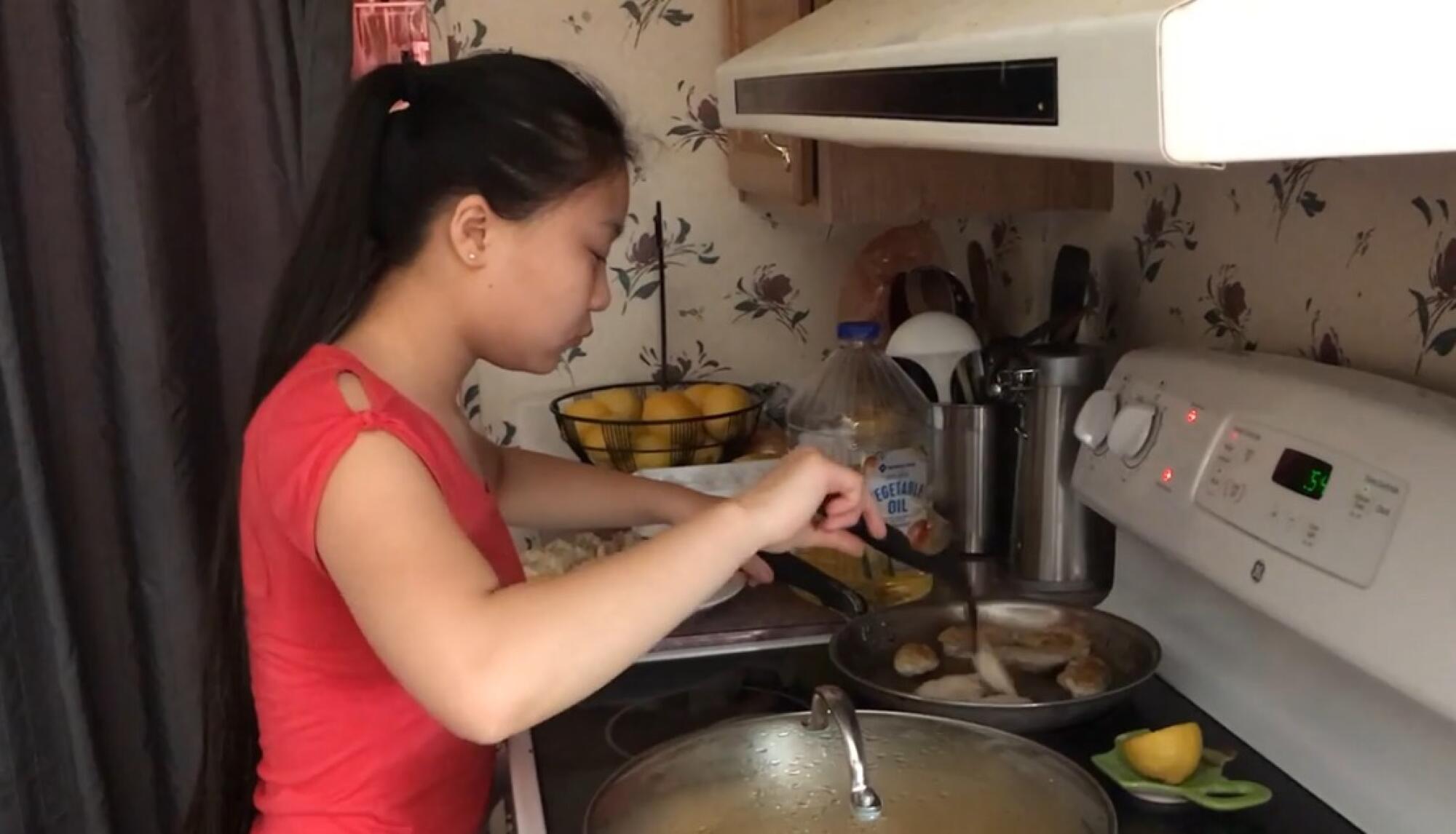
::
I was helping Esther in my free time at my expense — perhaps to make amends for the pain my reporting had caused the family. I was uncertain I could ever write anything, given their desire for privacy. So I was surprised when Marsha agreed to travel to China with me and let me tell their story. I helped with logistics and finances.
The trip took place in February 2019, around Chinese New Year, because it was the only time Shuangjie had more than a few days off work.
After reaching Changsha, a mega-city of 7 million, we headed south on a six-lane highway, eventually turning onto roads that got narrower as they ascended into mountains shrouded in rain clouds. The road was wet and plastered red with the wrapping of the spent fireworks set off for the holiday.
The rain blurred our vision. There are no street numbers in the mountains, and I wasn’t sure if I would recognize the Zeng family’s house, until I saw Shuangjie.
She stood alone in the middle of the road in a parka and pink suede boots. Now, more confident than I remembered her, she took charge of the situation. She peered into the back as though she knew that’s where Esther would be sitting.
Esther climbed out first. Shuangjie lightly touched her arm, to help her out.
“Esta,” she said softly, unable to pronounce the final syllable of her name.
The twins didn’t look directly at each other. They stood side by side, facing a photographer we had brought along. Nobody spoke. Nobody moved. I imagined the twins as a bride and groom in an arranged marriage meeting for the first time.
Shuangjie ushered Esther into the house and into a dining area where a square table was laid out with a red tablecloth for New Year. An older sister poured hot water from a thermos into paper cups to warm us. There was no heat and we could see our breath.
I had envisioned tears, hugs, perhaps somebody fainting or even collapsing. That’s what happened when I covered a reunion of a birth family and adoptee years earlier. But histrionics were not in the style of the Zeng family.
Both of the birth parents hung back. The mother, Zanhua, hadn’t even come out to greet us. She remained in the kitchen cooking over a gas burner; after she carried out half a dozen porcelain bowls of chicken, rabbit, duck, beef (all slaughtered for the New Year), she said only, “Eat, eat before it gets cold.”
That first meal was like a formal banquet. Esther smiled politely and, with impeccable manners, thanked Shuangjie for making her feel welcome. She and Shuangjie stole glances at each other but didn’t dare look each other straight in the eye.
We came back to the village every day for the rest of the week, taking seats at the square table. The Frederick family members became more adept with their chopsticks and more accustomed to spicy food. The Zeng family got used to Marsha praying at the beginning of every meal.
Shuangjie braided Esther’s hair. Marsha showed the Chinese family a photo album she had prepared of their life in Texas.
Esther was bursting with questions. I could tell she was frustrated that she could not remember any of the dramatic events that took place in the first two years of her life.
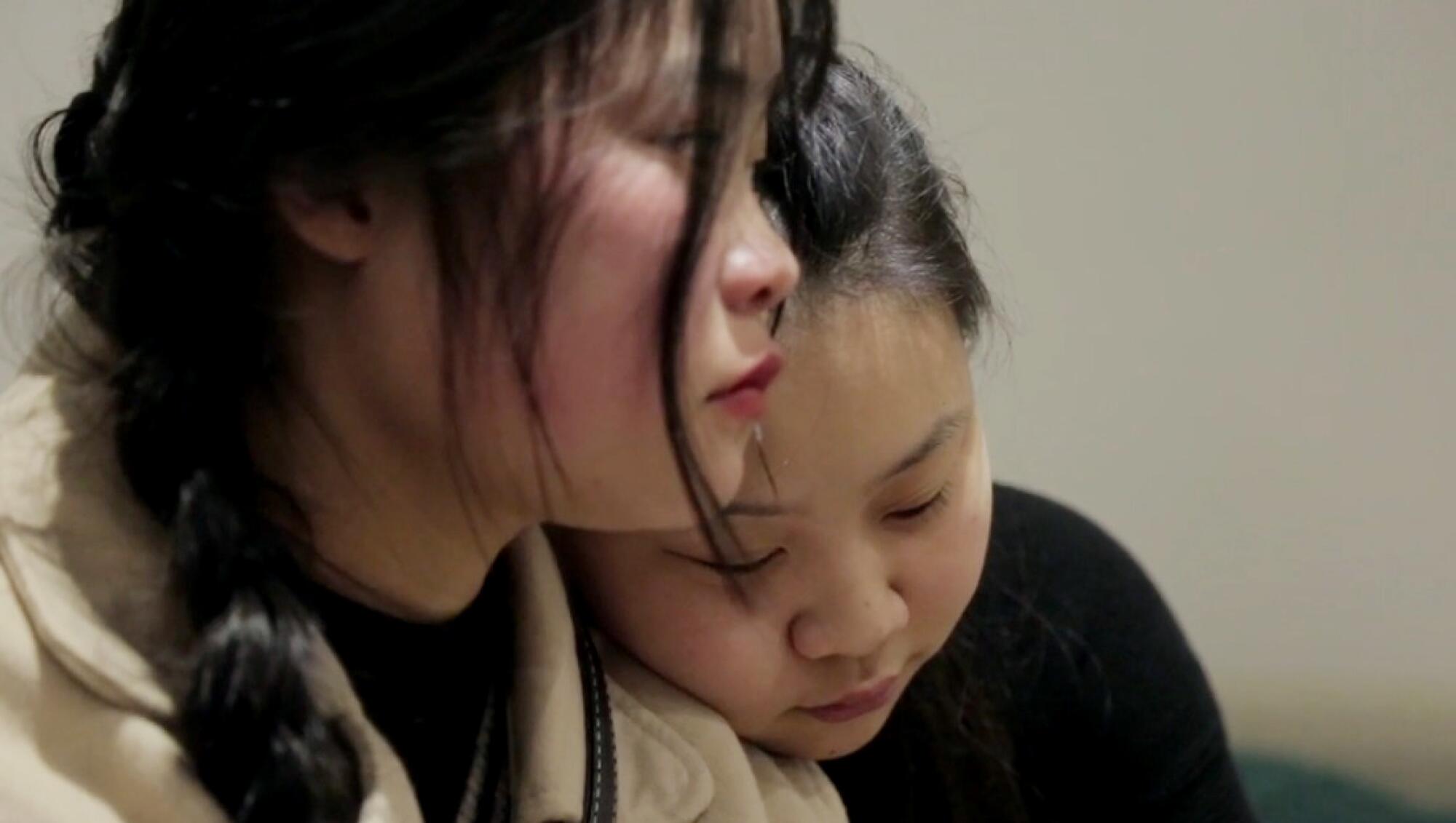
To answer, Zanhua took her to the place where she was born. It was in a grove of bamboo and pomelo trees hidden away between the rice paddies. The labor had been easy — just a few hours — and Esther came out quickly, headfirst. But Shuangjie was a breech birth, smaller and weaker.
Zanhua had planned to leave her four girls with relatives so she and her husband could earn money in the city. This is a common arrangement among rural Chinese. But Shuangjie was still weak and colicky, and they needed to keep her with them.
We went to visit the aunt and uncle who had cared for Esther. The uncle, Yuan Guoxiong, a short, broad-shouldered man in a leather jacket with a cigarette dangling from his lip, looked suspiciously at Esther, as though she were an impostor. He then pushed aside her hair to inspect her ear. Seeing the telltale tag, he warmed up.
“It’s been 16 years since we’ve seen you,” he said, apologizing for his earlier reticence. “You are welcome.”
He and his wife reminisced about the girl they called Fangfang, a plump and precocious toddler. She could walk and talk when she was barely more than a year old, and knew her way around the village.
“She was really clever,” said the aunt, Zhou Xiuhua. “Everybody knew that. We think that’s why family planning was after her.”
The one-child policy had given rise to a family planning apparatus that was as powerful as the police. They could demolish houses and lock up people who’d had excess births and couldn’t pay the fines. They weren’t allowed to take away babies, but sometimes they did.
Babies had become a lucrative commodity. Foreign families had to donate $3,000 in cash to orphanages. The money was used to fund social services locally, but sometimes it lined officials’ pockets.
The twins’ family suspects family planning officials were tipped off by the midwife who delivered the girls. Officials frequently visited the home of the uncle and aunt. Usually the family saw them coming and escaped with the baby through a back window into the fields. But one warm day in 2002, when the doors were wide open to air out the house, the officials caught them by surprise.
Xiuhua said the men barged into the house and grabbed Fangfang. The girl wrapped her arms around her aunt’s legs, screaming.
“There were five big men. One held my arms behind my back. One held my legs,” recalled Xiuhua, tears streaming down her cheeks. “I couldn’t do anything. They took Fangfang and threw her into a car. I tried to run after them, but I was barefoot.”
Family planning officials demanded varying sums of money in return for the baby, settling for the equivalent of about $1,000. The aunt and uncle borrowed money from neighbors, but then family planning asked for more, which they didn’t have. With mobile telephones rarer then than now among migrant workers, they couldn’t reach the girls’ parents, who were working 450 miles away.
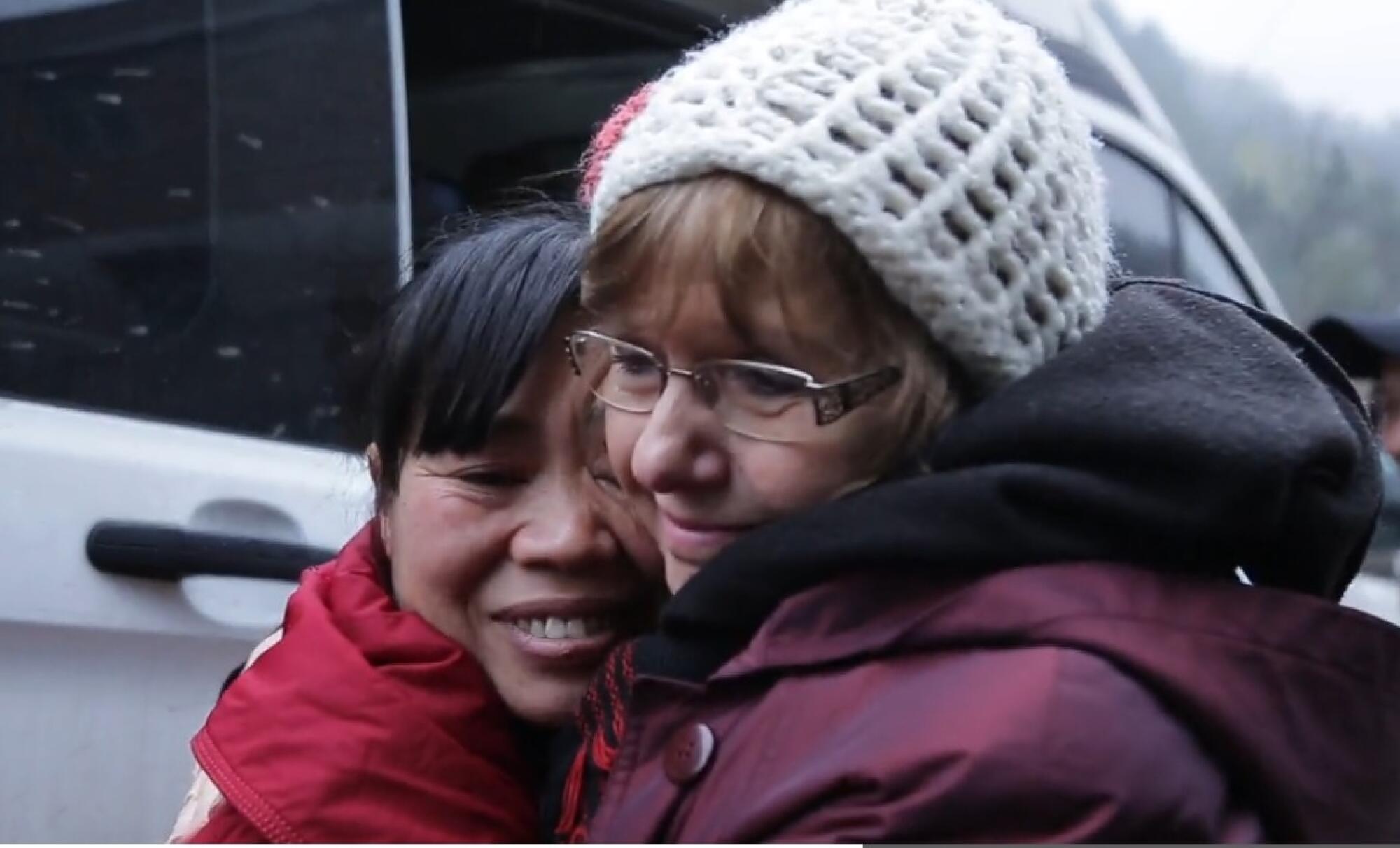
By the time the birth parents returned to attend a funeral, it was too late. Fangfang had been taken to the orphanage, and family planning said she’d been sent away.
“We always wanted to find you,” her father told Esther. “But it seemed impossible.”
But then, a glimmer of hope. The family consulted a fortuneteller who told them that one day they would see their missing daughter again.
::
After four days in the village, Esther’s adoptive and birth families felt as bonded as they could for people who don’t share a language and culture. Esther held hands with her birth parents and sisters. Zanhua hugged Marsha, in contrast to the first day, when she pulled away when Marsha attempted a hug. Esther’s birth sisters embraced Victoria. The families posed for dozens of photographs.
Marsha gave the speech that she had in effect practiced for nearly 10 years, ever since she found out Esther had been stolen from her family. “Esther’s name means star. She has been a bright star in my life,” she began. “But I would never have adopted her if I knew she was stolen from you. It gives me pain knowing that my gain was your loss.”
The father, Youdong, in turn offered profuse thanks to Marsha.
“I am grateful to you. I can see that you raised her very well.”
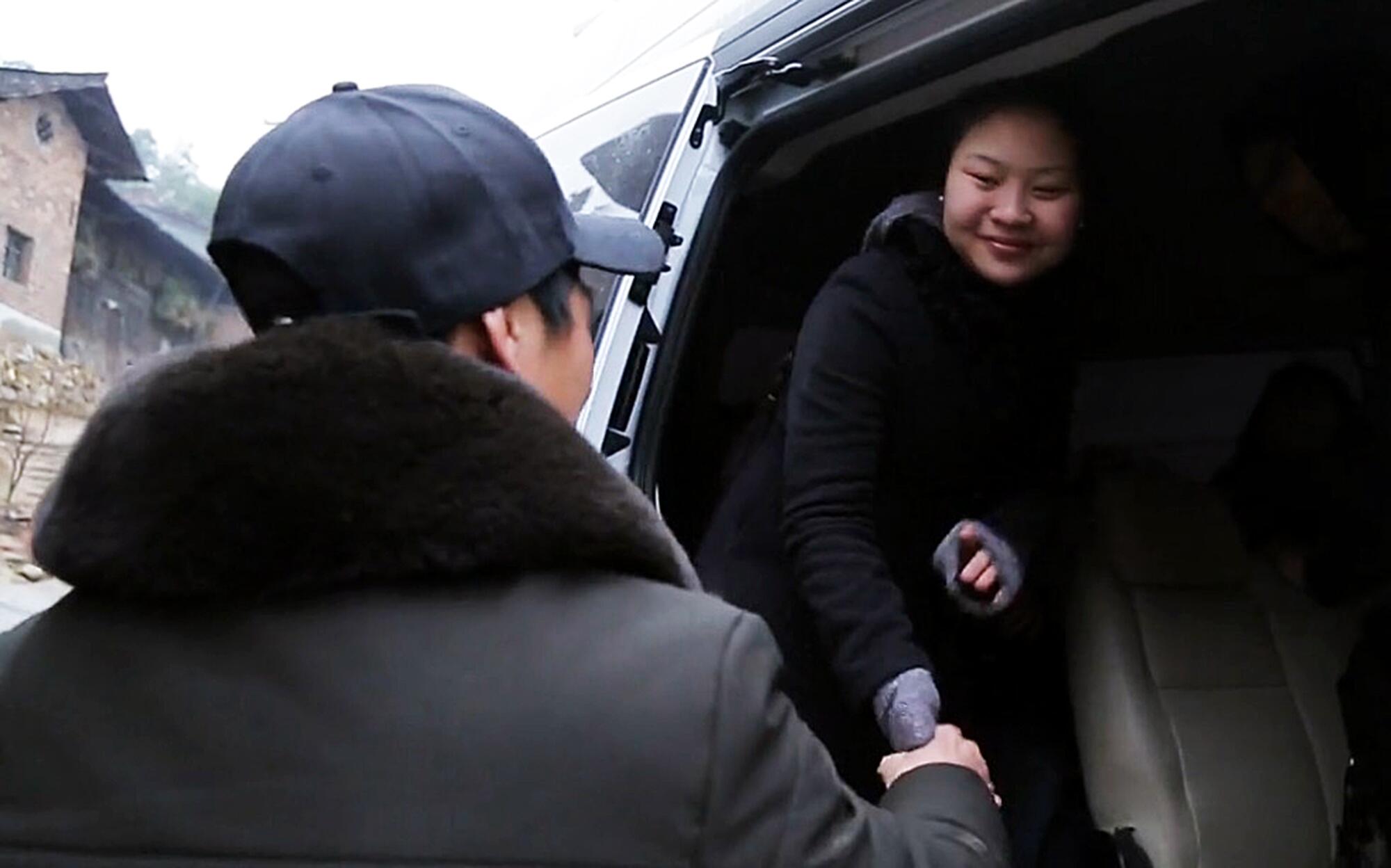
Esther promised her birth parents she would visit again and that, if she married, she would bring her husband and children to meet them. Everyone beamed.
As we were leaving the village, Zanhua took me aside and said that during my first visit in 2009, I promised that I would return and bring their daughter. I told her I didn’t remember any such promise and doubted I would have made it. But I appreciated her gratitude just the same.
Shuangjie rode back with us to Changsha, and in the relative privacy of the backseat, she and Esther bombarded each other with questions. “Do you have a boyfriend?” was one of the first. Neither did. Neither seemed keen on getting married too soon.
They taught each other words in their respective languages — Happy New Year, hair, food, sisters. When the interpreter got exhausted from the effort, they turned to a translation app on Shuangjie’s smartphone. But for the most part, they communicated as they had before, through gestures and games. They played cards and pat-a-cake clapping games, in effect living the childhood denied them. They reveled in their similarities (both are adept at rolling their tongues).
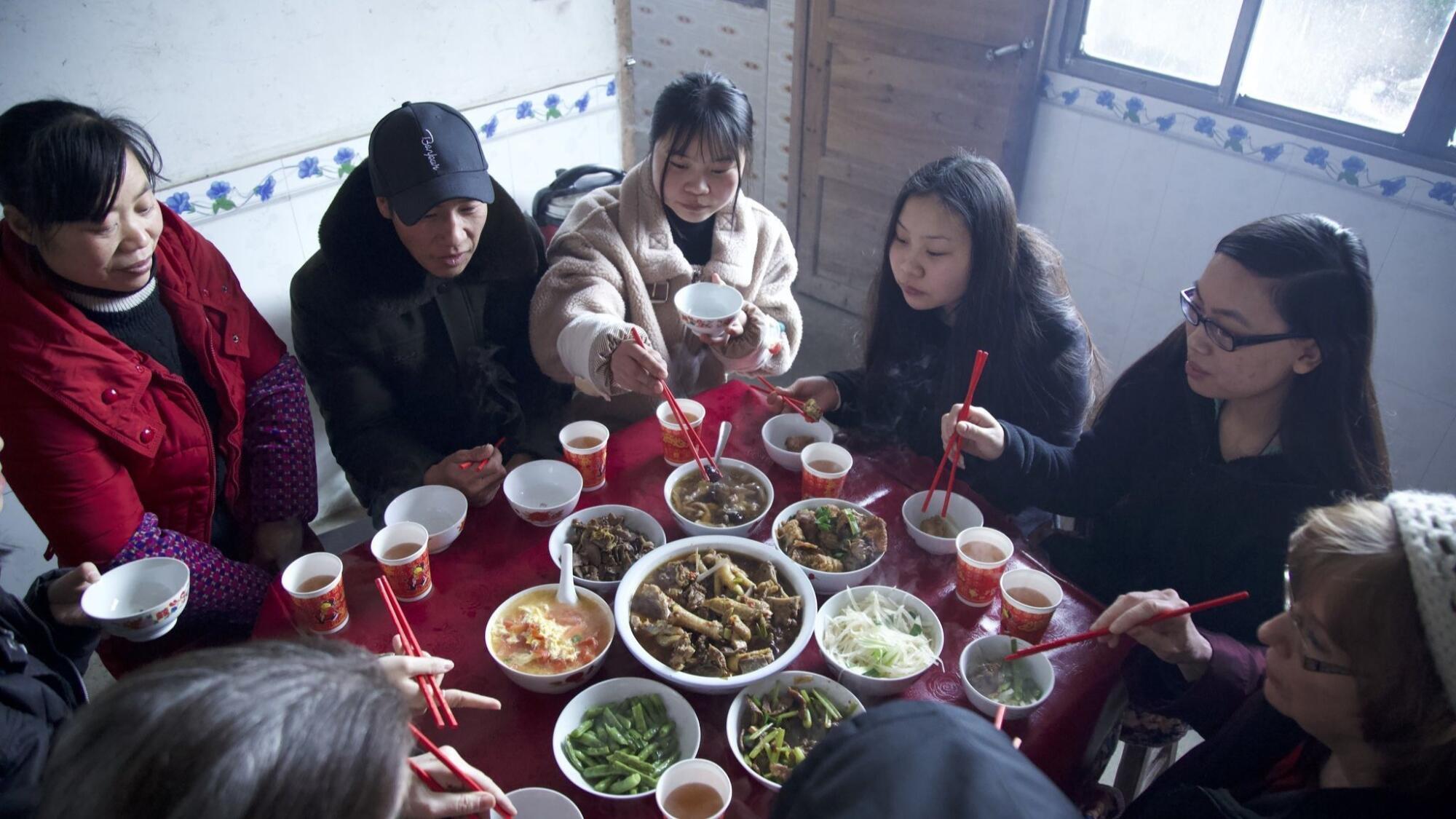
“There is another me out there in the world,” Shuangjie exclaimed with delight.
Both cried when it was time for Esther to go. And yet I had the sense this was not an end, but a beginning.
Nearly 150,000 children have been adopted from China since 1992, 96,000 of them Americans, mostly girls. Thousands have returned to China to learn about their origins and search for their birth families. Perhaps a few dozen have succeeded. Often, though, the relationship between adoptees and their birth parents is complicated by misunderstandings and recriminations. It struck me that it was easier for Esther to bond with her birth parents because of the way she had been seized. And she had Shuangjie.
When I saw Esther a few months after the reunion, she was starting to teach herself Chinese from websites and library books.
And she was planning for their next reunion. “Shuangjie doesn’t like burgers. I’m thinking about what I should cook for her.”
Nicole Liu of The Times’ Beijing bureau contributed to this report.
Production by Jessica Martinez
More to Read
Sign up for Essential California
The most important California stories and recommendations in your inbox every morning.
You may occasionally receive promotional content from the Los Angeles Times.


